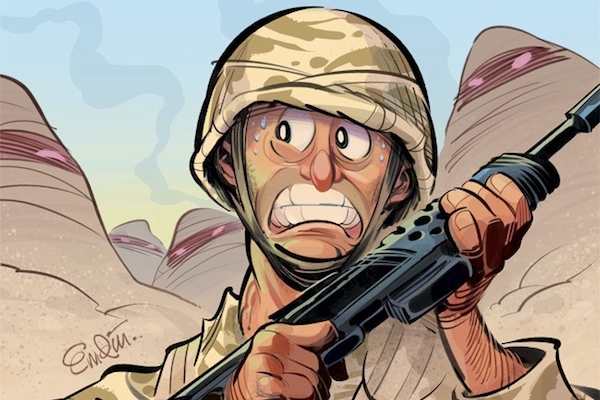MPs on the Defence Select Committee made a similar warning this morning about the UK’s withdrawal from Afghanistan as Con Coughlin made in The Spectator last month. He wrote that Britain’s ‘attempt to undertake a dignified retreat from Kabul has all the makings of yet another Afghan disaster’. You can read the full piece here, but here are the main points that it makes, followed by the main warnings from the select committee’s report:
1. Is the ANSF ready to take over?
Because of a failure to defeat or reach a political settlement with the Taleban, the withdrawal plan depends on trusting Afghan troops ‘who have already shown a worrying ability to switch sides’. Coughlin outlined a trend of ‘green on blue’ killings in recent months.
The Defence Committee’s report this morning said ‘we remain concerned that, as withdrawal and the final handover to the ANSF draws near, violence levels have not fallen. The lack of progress in reducing violence does not auger well for improving security and economic development on a long-term sustainable basis’. Keeping the ANSF a ‘cohesive and loyal force’ depends in part on those forces having confidence that they have the necessary support from the air and medical care when engaged in conflict with insurgents.
2. Is a withdrawal in 2014 right?
The 2014 withdrawal date was agreed by Washington and London in spite of judgements from those leading the task force that it was a ‘task which one measures in decades’.
‘We are convinced that the withdrawal of troops will not be as straightforward or risk-free as the MoD tells us,’ the committee’s report said, demanding that ministers share their detailed plans for withdrawal with the MPs. These would include:
– An orderly handover of responsibility for security to the ANSF.
– An orderly withdrawal of men with appropriate levels of protection.
– An orderly withdrawal of equipment or its safe disposal (on which more below).
– Collaboration with NATO, other allies, and Afghanistan.
– A contingency plan for an unexpected breakdown of security in the country or resistance to the UK’s withdrawal.
– An outline of how the MoD will assess the success of the withdrawal.
3. What to do with British equipment
The amount of equipment that needs shifting complicates the task further. There is £4bn worth of British equipment in Afghanistan. That includes 3,000 armoured vehicles. Some basic equipment such as tyres and air-conditioning units will be left in Helmand, some is being flown out, and the rest must be transported out overland. But this isn’t easy: the Pakistanis have demanded hefty bribes to guarantee the safe passage of Nato men and equipment. Meanwhile officials and ministers are trying to work with Uzbekistan and Kazakhstan.
But there are also ‘significant gaps’ in the ANSF’s equipment and logistics provisions, according to the Committee. It recommended that the Ministry of Defence investigate the ‘likely shortfalls in ANSF capabilities’ and how it could meet them. It also argued that the military needed to give the ANSF more opportunities to ‘test themselves in challenging circumstances’.
4. Will Afghanistan become a peaceful country?
It is even more difficult to claim that Afghanistan has been pacified than it was for Iraq. Opium cultivation has risen by a fifth last year, according to some reports. The Taleban has a parallel governing structure in preparation for the withdrawal.
Today’s report took a similarly dim view of the prospects for peace in the country. It said:
‘We hope that Afghanistan can become a secure, prosperous and flourishing country but we are concerned that Afghanistan could descent into civil war within a few years. Engaging with the Taliban in the peace process will clearly be necessary. In response to this Report, the Government should spell out what steps it intends to take to at least hold on to the progress made so far.’
Defence Secretary Philip Hammond this morning defended the progress ISAF had made in the country. He said:
‘I completely accept that nobody can say with certainty what the future for Afghanistan will be, but what I can say is that the future of Afghanistan will have to be determined by the Afghan people. What we have done is given them that opportunity, we have created that breathing space. We now have Afghan security forces which are able to suppress the insurgency and create the space for the Afghan state to show its people what it can do and what it is doing – it’s delivering healthcare, it’s delivering a better system of justice than it’s had in the past, it’s delivering education – dramatic steps forward in education, particularly the education of girls.’
Read Coughlin’s full piece here, and the Defence Committee’s report here. Click here to subscribe to The Spectator.







Comments